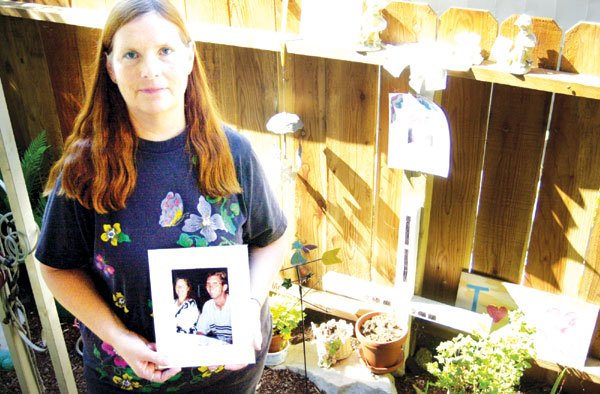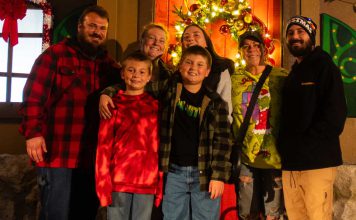Trudy Parks has a photo album. A few pages of baby pictures, a
couple of more recent photos from a trip to Great America,
intermingled with cards, poems and letters.
”
This is what Dustin looks like
… looked like,
”
Parks says.
Aug. 27 marked the end of the first year she’s spent without her
son, who killed himself on that date in the back of a blue Dodge
Dakota quadcab on the road that leads to Henry Coe State Park.
Trudy Parks has a photo album. A few pages of baby pictures, a couple of more recent photos from a trip to Great America, intermingled with cards, poems and letters. “This is what Dustin looks like … looked like,” Parks says.
Aug. 27 marked the end of the first year she’s spent without her son, who killed himself on that date in the back of a blue Dodge Dakota quadcab on the road that leads to Henry Coe State Park.
“I have to learn to live my life all over again without him,” says Parks. “First Thanksgiving, first Christmas, first Mother’s Day. It’s constantly hitting me that Dustin’s not here … His clothes are still in their drawers.”
People near to her tend to ask Parks if there was something they could have done to prevent Dustin’s suicide.
There wasn’t, his mother believes. “Once he made up his mind, he was going to do it no matter what.”
Dustin, a single man who was handy at fixing things, often helped out neighbors with home and yard projects for free. He loved children. He had just turned 33 when he inexplicably thanked his coworkers at A Tool Shed in Morgan Hill for “their help” and left work one morning at 11. He came home and scrawled a brief note in red marker on a piece of paper – “I have to do it. Love ya.” – before grabbing his .357 magnum and driving to the State Park.
“He was having a lot of depression problems,” says Parks, who lives in Morgan Hill with her husband Ralph. “He was on Paxil (an anti-depressant) and the doctor was switching him to another medication. We had a talk and he told me that he was thinking about suicide.
He realized that it was probably going to hurt a lot of people, but he said he felt like things would be better for everyone if he wasn’t around. To other people it was a shock, but I knew as soon as I saw that note.”
Even in death, Dustin tried to be considerate. He unplugged his radar scanner so the truck’s battery wouldn’t be drained, and neatly folded his jacket and placed his glasses on the front seat. He ended his life in the bed of the pickup, his most prized possession, so that he wouldn’t mess up the cab.
Suicide, while rarely talked about in American society, is a silent epidemic. Among young people 15 to 24 it is the third leading cause of death. And among the elderly, who often face loneliness and pain, the suicide rate is 50 percent higher than that of any other age group, according to Suicide Prevention Service statistics.
In San Benito County there were 11 suicides between 1999 and 2003. More populous Santa Clara County experienced 217 in 1998 alone, more than four times the county’s homicide rate. Nationwide, suicide is also more common than homicide (the 8th and 13th leading causes of death, respectively).
People who have lost a loved one to suicide, suffered multiple personal losses, have mental health issues or are in the grip of substance abuse problems are the most likely to make an attempt on their own life, says Diane Brice, program director for Suicide Prevention Service of the Central Coast, which serves Santa Cruz, Monterey and San Benito counties.
“Basically, the highest risk is when people are becoming isolated,” Brice says. “We can bear almost anything as long as we don’t have to bear it alone. If people are isolated, or even if they are surrounded by loving family and friends but don’t know how to reach out, they can be at greater risk.”
In the immediate aftermath of such a loss, family members are often left pondering the same question: Why?
“I was in complete shock,” says Michele McCarthy, 39, of the day she heard her nephew committed suicide.
Dale Buehler, Jr. was 17 when he took his own life. An outdoorsy young man, he was also funny and known as the class prankster.
“There were probably warning signs, but I think a lot of it was impulsive,” McCarthy says. “I know that my nephew didn’t want to die, he just wanted that pain he was feeling to end.”
Buehler’s death had a radical effect on his family. Dale Buehler, Sr. committed suicide himself in 2001, unable to come to terms with the loss of his son. McCarthy turned her despair into action, volunteering for the Suicide Prevention Service. She answered calls on the suicide hotline, talking to people with broken hearts, those who were concerned for others and those who were on the brink. She took Dale Jr.’s picture to local schools and talked to kids about suicide.
“My nephew looked just like any other kid – like one of them,” she says.
Today she oversees the Prevention Service’s suicide hotline as director of crisis services. “We get over 550 calls per month and we de-escalate 99 percent of those,” McCarthy says.
“I think one of the most important things is to just keep talking about it because there is such a stigma. I’ll talk to anyone about it because it’s important for them to know that there is a hot line, that there are people they can call 24/7.”
If you would like to learn more about suicide prevention, or if you have experienced a recent loss, here are some Web sites you may wish to visit:
www.Suicidology.or
www.SiblingSurvivors.com
www.SurvivorsOfSuicide.com
www.ParentsOfSuicide.com
www.YellowRibbon.org,
www.1000Deaths.com
Warnings and ways to handle them
If you are concerned about a loved one, here are some of the warning signs you might want to be on the lookout for:
• They talk about suicide, death or “just wanting the pain to end.” Many people experience suicidal feelings during their lifetime. For each of the 31,000 successful suicides in the U.S. each year, there are probably three or more attempts, Suicide Prevention Service of the Central Coast Program Director Diane Brice says.
• They withdraw from friends or social activities. A deeply depressed person may withdraw from friends and loved ones as they become increasingly isolated.
• They have had a recent severe loss. The loss of a relationship is a frequent watershed point for someone who is on the brink. In her attendance at grief groups, Trudi Parks has discovered that it’s often a small thing that pushes someone over the edge.
“They die, but you can see that the problem might have been fixed in a week,” she says. “It’s just that one little thing that they couldn’t deal with on top of everything.”
• They’re preparing for death. Making out a will unexpectedly, giving away prized possessions or buying in to pre-arranged burial services could all be tip-offs to a plan for suicide. These are warning signs that are often undetectable in seniors, since many do these things as a normal part of the preparation for their imminent natural death.
• They have attempted suicide before. Someone who got close to the brink before is more willing to see suicide as the answer. Likewise, someone who has lost a loved one to suicide is 40 times more likely to commit suicide themselves.
• They’ve increased their drug or alcohol intake. Dependence on drugs or alcohol may be a seriously depressed person’s way of attempting to deal with their despair, burying it in a bottle rather than seeking help. An increase in this behavior may represent deepening depression.
• They have a suddenly upbeat attitude. People like having a plan. Those who are deeply depressed often feel hopeless, but developing a plan, even if it is for their own death, can often alleviate their symptoms of depression temporarily.
“It isn’t uncommon for people who are suicidal to be suddenly happy, even elated, because now they have a plan – a day and a time and a means with which to wrap things up,” Brice says.
If you want to speak with someone who you think is suicidal, here are a few guidelines:
• Talk directly about suicidal feelings. It may be hard to do, but you will need to ask direct questions. (Have you been considering suicide? Do you have a plan? Have you set a date?) Try to be nonjudgmental as you listen to the answers.
• Listen. Don’t debate the morality of suicide or lecture on the value of life. Don’t act shocked, be sworn to secrecy or ask why, advises the American Association of Suicidology. Don’t offer reassurance or give advice. Instead, offer empathy, hope that there are alternatives out there and accept their feelings.
• Be active. If you know how the person intends to commit suicide, remove the means if possible. Never leave a highly suicidal person alone, even for a moment.
If you have been thinking about suicide, you’re not alone, but you need to seek help. Telling someone about your feelings can help you to get through a “life-threatening loneliness.” Talk to someone you trust or, if you’re feeling like no one understands, consider calling a crisis hotline. Suicide Prevention’s is 24-hour. Their toll-free number is (877) 663-5433.
Help wanted!
Suicide Prevention of the Central Coast is looking for volunteers. Training starts Oct. 12. No formal training is required – just a big heart and an open mind. Call (831) 459-9373 or (831) 375-6966 for more information.














